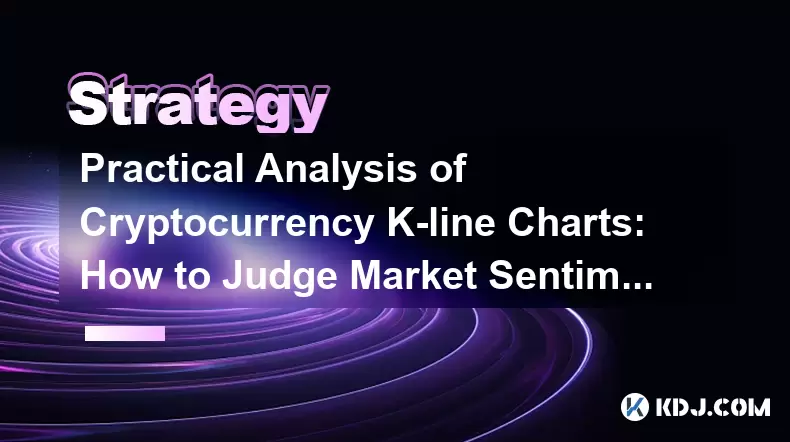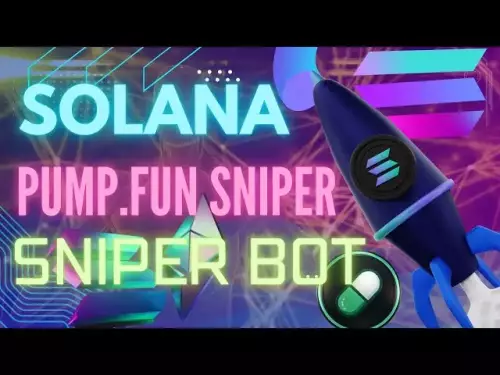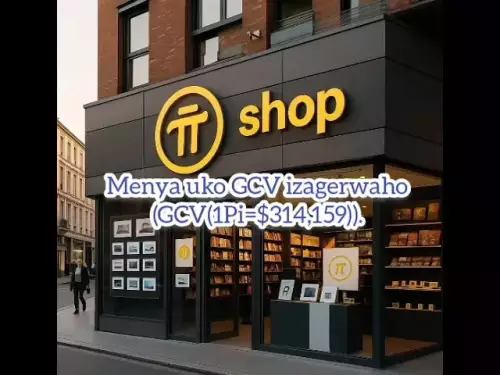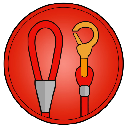-
 bitcoin
bitcoin $112195.049338 USD
2.42% -
 ethereum
ethereum $4124.915858 USD
2.81% -
 tether
tether $1.000570 USD
0.02% -
 xrp
xrp $2.861568 USD
2.25% -
 bnb
bnb $1000.346670 USD
3.04% -
 solana
solana $209.070819 USD
3.38% -
 usd-coin
usd-coin $0.999870 USD
0.02% -
 dogecoin
dogecoin $0.235379 USD
2.65% -
 tron
tron $0.335681 USD
-0.20% -
 cardano
cardano $0.803501 USD
3.38% -
 hyperliquid
hyperliquid $47.120881 USD
3.56% -
 chainlink
chainlink $21.501300 USD
3.44% -
 ethena-usde
ethena-usde $1.000571 USD
0.02% -
 avalanche
avalanche $29.793378 USD
3.62% -
 stellar
stellar $0.366964 USD
2.42%
Practical Analysis of Cryptocurrency K-line Charts: How to Judge Market Sentiment through Charts
Cryptocurrency K-line charts visually represent price movements through candlesticks, showing open, high, low, and close prices to help traders analyze market trends and make informed decisions.
Jun 10, 2025 at 09:42 pm

Understanding the Basics of Cryptocurrency K-line Charts
Cryptocurrency K-line charts, also known as candlestick charts, are essential tools for analyzing price movements in the crypto market. Each candlestick represents a specific time frame, such as 1 minute, 5 minutes, or even daily intervals. The structure of a K-line includes four key data points: open, high, low, and close prices.
The body of the candlestick shows the range between the opening and closing prices, while the wicks (or shadows) indicate the highest and lowest prices reached during that period. A green (or white) candle means the closing price was higher than the opening, signaling bullish sentiment. Conversely, a red (or black) candle indicates a bearish trend where the closing price is lower than the opening.
Understanding these basic elements helps traders interpret short-term market behavior and make informed decisions.
Identifying Key Patterns in K-line Charts
K-line patterns can reveal potential reversals or continuations in price trends. Some of the most commonly used patterns include:
- Bullish Engulfing Pattern: This occurs when a small red candle is followed by a larger green candle that completely engulfs it. It often signals a shift from a downtrend to an uptrend.
- Bearish Engulfing Pattern: The opposite of the bullish engulfing pattern, this involves a small green candle followed by a large red candle, indicating a possible reversal from an uptrend to a downtrend.
- Hammer and Hanging Man: These candlesticks have small bodies and long lower wicks. A hammer appears at the bottom of a downtrend and suggests a potential reversal upward, while a hanging man appears at the top of an uptrend and may signal a downward reversal.
- Doji: A Doji forms when the opening and closing prices are nearly equal, reflecting indecision in the market.
Recognizing these patterns allows traders to anticipate changes in market sentiment before they fully materialize on broader technical indicators.
Using Volume to Confirm Chart Signals
Volume plays a crucial role in validating the strength of a particular K-line signal. High trading volume accompanying a candlestick pattern increases the likelihood that the pattern is genuine and not just noise.
For example, if a bullish engulfing pattern forms with significantly higher volume compared to previous candles, it reinforces the idea that buyers are stepping in aggressively. On the other hand, a similar pattern forming with low volume might suggest weak conviction and a higher probability of failure.
Traders often use volume bars beneath the K-line chart to monitor buying and selling pressure. A sudden spike in volume during a breakout or breakdown can serve as confirmation of a strong move.
Analyzing Support and Resistance Levels Through K-line Formations
Support and resistance levels are critical in understanding how the market perceives value. K-line formations near these zones can provide powerful clues about potential price reactions.
When a cryptocurrency’s price approaches a known support level and forms a bullish reversal candle like a hammer or morning star, it may indicate that buyers are stepping in. Similarly, when approaching resistance and forming bearish candles like shooting stars or evening stars, it could signal that sellers are taking control.
Multiple K-line candles forming near the same support or resistance area add more weight to those levels. Traders often combine K-line analysis with horizontal lines drawn on the chart to visualize these psychological barriers.
Combining K-lines with Moving Averages for Better Accuracy
While K-line charts are valuable on their own, combining them with moving averages enhances accuracy in reading market sentiment. Moving averages smooth out price data to create a single flowing line, making it easier to identify trends.
Commonly used moving averages include the 50-day and 200-day simple moving averages (SMA). When a green K-line closes above a key moving average, especially after a pullback, it may signal a continuation of the uptrend. Conversely, red K-lines consistently below a moving average could indicate ongoing bearish momentum.
Traders also watch for crossovers — when a shorter-term moving average crosses above a longer-term one (a 'golden cross'), it can confirm a bullish K-line pattern. The opposite, a 'death cross,' supports bearish readings.
Frequently Asked Questions
Q: Can K-line charts be used for all cryptocurrencies?Yes, K-line charts apply universally across all tradable assets, including Bitcoin, Ethereum, altcoins, and stablecoins. However, liquidity and volatility differences may affect the reliability of patterns, so caution is advised when analyzing less-traded tokens.
Q: How do I choose the right time frame for K-line analysis?Time frames depend on your trading strategy. Day traders often use 1-minute to 15-minute charts, while swing traders prefer 1-hour to daily charts. Longer time frames tend to offer more reliable signals but fewer trading opportunities.
Q: Is K-line analysis enough for successful trading?No single method guarantees success. While K-line analysis provides insight into market psychology, it works best when combined with volume analysis, trendlines, and possibly fundamental factors like project news or macroeconomic events.
Q: Are there any tools or platforms that enhance K-line chart analysis?Many platforms like Binance, TradingView, and CoinMarketCap offer advanced K-line charting tools. Features like customizable indicators, drawing tools, and real-time alerts help traders analyze candlestick patterns more effectively.
Disclaimer:info@kdj.com
The information provided is not trading advice. kdj.com does not assume any responsibility for any investments made based on the information provided in this article. Cryptocurrencies are highly volatile and it is highly recommended that you invest with caution after thorough research!
If you believe that the content used on this website infringes your copyright, please contact us immediately (info@kdj.com) and we will delete it promptly.
- News, September 28th, Headlines: Crypto's Wild Ride
- 2025-09-29 20:45:13
- Altcoins, Investors, and Potential Gains: Riding the 2025 Crypto Wave
- 2025-09-29 20:45:13
- Citi Token Services: Revolutionizing Cross-Border Payments and Liquidity Management
- 2025-09-29 20:50:01
- JYAI Token Gears Up for Launch: LCX Exchange Listing Imminent
- 2025-09-29 20:50:01
- Prenetics, Bitcoin Holdings, and Corporate Bitcoin: A New Era?
- 2025-09-29 20:25:11
- Swift, Altcoins, and Shifting Sands: Diving into Crypto's Latest Details
- 2025-09-29 20:25:11
Related knowledge

Practical parameter settings for a Bitcoin multi-timeframe moving average system
Sep 18,2025 at 10:54pm
Optimizing Timeframe Combinations for Bitcoin Trading1. Selecting appropriate timeframes is crucial when building a multi-timeframe moving average sys...

How can I filter out false breakouts in Dogecoin high-frequency trading?
Sep 22,2025 at 01:00am
Understanding False Breakouts in Dogecoin Trading1. A false breakout occurs when Dogecoin's price appears to move beyond a defined support or resistan...

Techniques for identifying tops and bottoms in the Bitcoin on-chain NVT model
Sep 20,2025 at 07:54pm
Understanding the NVT Model in Bitcoin Analysis1. The Network Value to Transactions (NVT) ratio is often described as the 'P/E ratio' of the cryptocur...

What does the surge in open interest in Bitcoincoin futures mean?
Sep 20,2025 at 11:18pm
Understanding the Surge in Dogecoin Futures Open Interest1. A surge in open interest within Dogecoin futures indicates a growing number of active cont...

How can I use the Ethereum USDT premium to gauge market sentiment?
Sep 18,2025 at 11:55pm
Understanding the Ethereum USDT Premium1. The Ethereum USDT premium refers to the price difference between USDT (Tether) traded on Ethereum-based plat...

What should I do if Ethereum staking yields decline?
Sep 20,2025 at 06:18am
Understanding the Causes Behind Declining Ethereum Staking Yields1. The Ethereum network transitioned to a proof-of-stake consensus mechanism with the...

Practical parameter settings for a Bitcoin multi-timeframe moving average system
Sep 18,2025 at 10:54pm
Optimizing Timeframe Combinations for Bitcoin Trading1. Selecting appropriate timeframes is crucial when building a multi-timeframe moving average sys...

How can I filter out false breakouts in Dogecoin high-frequency trading?
Sep 22,2025 at 01:00am
Understanding False Breakouts in Dogecoin Trading1. A false breakout occurs when Dogecoin's price appears to move beyond a defined support or resistan...

Techniques for identifying tops and bottoms in the Bitcoin on-chain NVT model
Sep 20,2025 at 07:54pm
Understanding the NVT Model in Bitcoin Analysis1. The Network Value to Transactions (NVT) ratio is often described as the 'P/E ratio' of the cryptocur...

What does the surge in open interest in Bitcoincoin futures mean?
Sep 20,2025 at 11:18pm
Understanding the Surge in Dogecoin Futures Open Interest1. A surge in open interest within Dogecoin futures indicates a growing number of active cont...

How can I use the Ethereum USDT premium to gauge market sentiment?
Sep 18,2025 at 11:55pm
Understanding the Ethereum USDT Premium1. The Ethereum USDT premium refers to the price difference between USDT (Tether) traded on Ethereum-based plat...

What should I do if Ethereum staking yields decline?
Sep 20,2025 at 06:18am
Understanding the Causes Behind Declining Ethereum Staking Yields1. The Ethereum network transitioned to a proof-of-stake consensus mechanism with the...
See all articles


























![[Pycoin] PI Coin -Shocking Listance of Pycoin?! 'Rebellion' This time ... Pay attention to #paikoin [Pycoin] PI Coin -Shocking Listance of Pycoin?! 'Rebellion' This time ... Pay attention to #paikoin](/uploads/2025/09/29/cryptocurrencies-news/videos/pycoin-pi-coin-shocking-listance-pycoin-rebellion-time-pay-attention-paikoin/68da82f23cec1_image_500_375.webp)















































